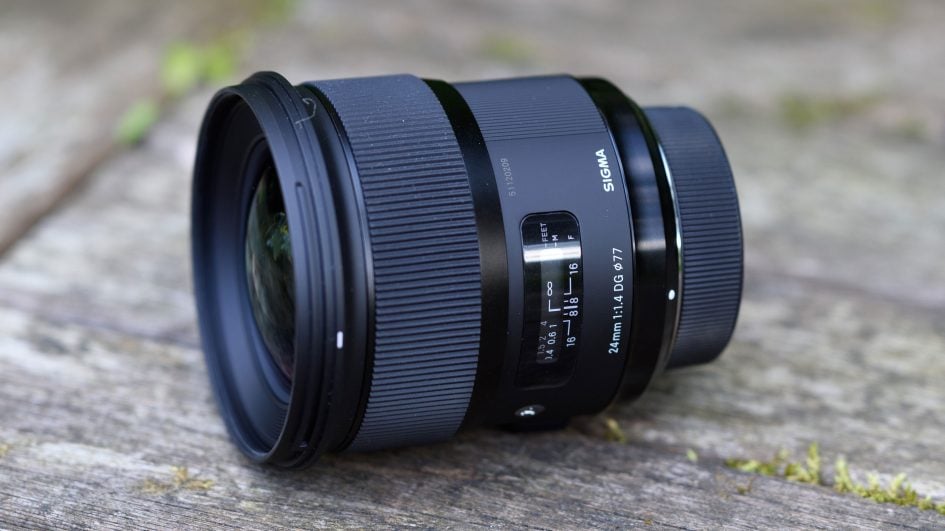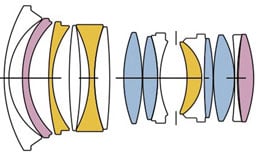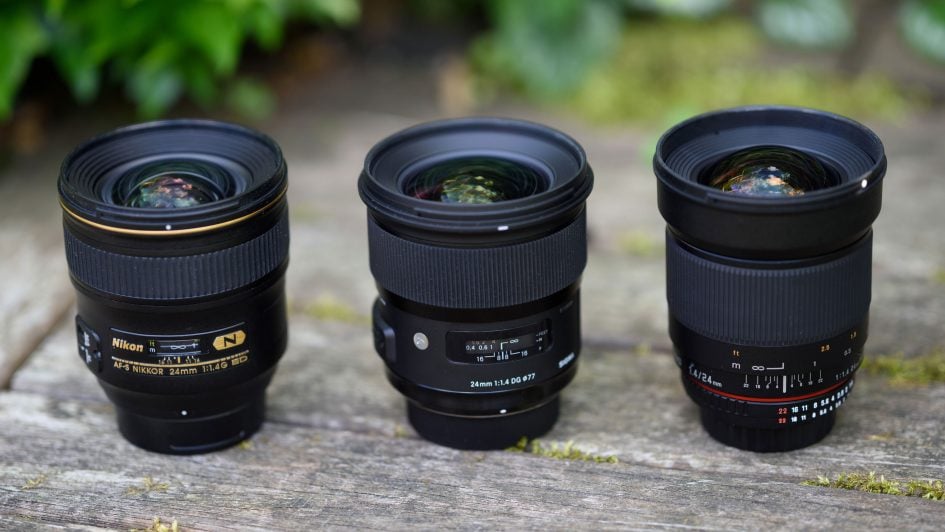Rokinon Wideangle 24mm F14 Vs Sigma Art 35mm F14 Dg Hsm
Summary
 The Sigma 24/1.4G Art is another winner in Sigma'southward line-upwards of wide-bending "Art" lenses. You lot tin can produce shots with image quality you might think were incommunicable at a wide open aperture of f1.4. Information technology has depression distortions, normal vignetting, petty longitudinal CAs, plus a fast and reliable AF (later on some tuning with the USB-dock). And the build-quality and the new design back up Sigma'due south claim to have developed and manufactured a lens to professional standards. I was quite impressed to see this lens surpass the optical operation of the venerable Nikon AF-Southward 24mm f/1.4G in most every attribute. Except for this dip in APS-C/DX corner performance at close distances. And I miss the conditions sealing at the lens-mount which seems a bit out of place for a lens targeted at professionals. Only other than that the Sigma 24mm f1.four DG HSM Fine art plays on a very high level - and it does deliver this impressive performance at a cost that is much lower than the 24mm f1.four models from Nikon or Canon. This clearly earns the new Sigma lens our Highly Recommended rating.
The Sigma 24/1.4G Art is another winner in Sigma'southward line-upwards of wide-bending "Art" lenses. You lot tin can produce shots with image quality you might think were incommunicable at a wide open aperture of f1.4. Information technology has depression distortions, normal vignetting, petty longitudinal CAs, plus a fast and reliable AF (later on some tuning with the USB-dock). And the build-quality and the new design back up Sigma'due south claim to have developed and manufactured a lens to professional standards. I was quite impressed to see this lens surpass the optical operation of the venerable Nikon AF-Southward 24mm f/1.4G in most every attribute. Except for this dip in APS-C/DX corner performance at close distances. And I miss the conditions sealing at the lens-mount which seems a bit out of place for a lens targeted at professionals. Only other than that the Sigma 24mm f1.four DG HSM Fine art plays on a very high level - and it does deliver this impressive performance at a cost that is much lower than the 24mm f1.four models from Nikon or Canon. This clearly earns the new Sigma lens our Highly Recommended rating.
Buy it at present!
Bank check prices on the Sigma 24mm f1.4 ART at Amazon, B&H, Adorama, or Wex. Alternatively get yourself a copy of my In Camera volume or treat me to a coffee! Cheers!
Sigma 24mm f1.4 Fine art review -
- Written past
Intro
The Sigma 24mm f1.4 DG HSM Fine art is a wide angle prime lens, available in Canon, Nikon and Sigma mounts. Announced in February 2015, it's the second widest prime lens in Sigma'due south highly acclaimed Art series which includes the 50mm, 35mm, and 20mm f1.iv models. Expectations are high since the 50mm and 35mm lenses earned our Highly Recommended award; see my Sigma 35mm f1.iv Art review or my Sigma 50mm f1.4 Fine art review. The 24mm Art is as well compatible with Sigma's USB dock for fine-tuning or firmware updates, and if you modify bodies, you tin can pay to have the mount swapped for your new organisation.
Large discontinuity 24mm lenses are quite bonny additions to interchangeable lens bodies of APS-C / DX or full-frame / FX format: On the cropped bodies they become equivalent to 35mm in coverage and f2 in depth of field which works well for reportage / street photography every bit information technology's fast and gives some background isolation. On a total-frame body the 24mm focal length delivers noticeably broader coverage than 35mm or 28mm lenses without beingness prone to some of the distortions that 20mm can produce. You lot capture more of architecture or landscapes plus the bright aperture of an f1.4 lens lets you shoot longer under diminishing light, while as well allowing you to isolate closer subjects at least a niggling from the groundwork.
As I likewise tested Nikon'southward ain AF-S Nikkor 24mm f1.4G and the manual focus Samyang 24mm f1.4 I can give you a good impression on how the Sigma compares to the competition. All lenses were tested on a 36MP Nikon D810 body.
PS – don't forget you lot tin can support my piece of work adjacent fourth dimension you order anything at Amazon, B&H or Adorama by first clicking through to them using the links higher up and in the sidebar. Information technology works for anything y'all order at whatsoever fourth dimension – thanks for your back up!

Facts from the catalog
Every bit usual I'll have a look at the technical data first. I've rated the features with a [+] (or [++]), when information technology's better than average or even state of the art, a [0] if it's standard or just average, and [-] if there's a disadvantage.
Size (diameter x length): 85 x xc mm. This is pretty decent although it'due south funny to come across a wide-angle lens being so long. [0]
Weight: 665g. Pretty heavy, but that seems to exist the standard for 24/ane.iv lenses as the respective offers from Nikon, Samyang and Canon are around the same weight (and size). [0]

Optics: fifteen elements in xi groups. This is pretty complex design with 22 glass/air-surfaces and a lot of special elements including two aspherical elements. "Super-Multi-Layer" coating should reduce flare and ghosting. [+]
Closest focus distance is 0.25m which gives you a working distance of effectually x cm when you don't utilise the lens-hood. Maximum magnification is 1:5.3. That'due south non much merely is standard in this lens-class. [0]
Filter-thread: All 24/i.4 lenses use 77 mm filters. That's the size that most pro-lenses use. [+]
Image stabilization: No 24 mm prime lens offers optical stabilization except for Catechism'southward EF 24mm f2.8 IS USM. And with the pocket-size magnification at a focal length of 24mm it is no big loss. Still: shooting dim interiors or landscapes in fading light hand-held tin prove quite a challenge without stabilization. [0]
Auto focus: The lens offers silent auto focus with transmission-focus override by turning the focus ring. Then it works on bodies without AF-motor similar the Nikon D3x00/v×00-bodies. That may sound like a standard feature but you can yet find lenses with a less optimal manual override machinery or fifty-fifty with manual focus only (like from Samyang). [+]
Coverage: covers full frame/FX or smaller = very adept. [+]
Price: The Sigma costs around 750 EUR (incl. xix% VAT) which is not inexpensive only a fair price for the ambition Sigma has for this lens. The AF-S 24/i.4G ED Nikkor for example costs more than double that at effectually 1700 EUR. Only the manual focus Samyang is fifty-fifty cheaper than the Sigma at around 550 EUR. [+]
Comes with a nice semi-soft lens-example that is well padded but has no strap, the lens-hood is included, reversible for send, and the lens-caps are like to Nikon'southward. [0]
Distance data is relayed to the camera, and so the Nikon body tin can do all the advanced exposure-related stuff with this lens. [+]
Aperture ring: No, which is standard. Only the Samyang offers one. [0]
Sealing: The lens has a safety grommets at the lens-mount. [+]
The score in the "features-section" is 0[-]/6[0]/7[+]. So zilch to rave nigh. But the Sigma has one big plus: it is by far the cheapest way to get a 24/1.iv lens that does AF.
Three alternative 24mm f1.iv lenses

Above left: Nikon AF-S 24/1.4G ED, eye: Sigma Art AF 24/1.4 DG HSM, correct: Samyang 24/1.iv ED AS UMC
Alternatives:
– If you're a Canon shooter in that location's the EF 24mm f1.4 L USM Ii priced at effectually 1500 EUR (incl. 19% VAT).
– For owners of Nikon DSLRs the gilded-ringed AF-S Nikkor 24mm f1.4G from 2010 is the near expensive of Nikon's current f1.4 lenses: 1700 EUR. Meet my Nikon 24/1.4G review.
– If you don't need AF there's a manual focus 24mm f1.4 ED AS UMC from Samyang which is the cheapest way to get a 24mm f1.iv lens: Information technology is priced around 550 EUR. See my Samyang 24/1.four review.
– If y'all tin can live with a maximum aperture of f/1.viii or even f/2.0 there are more than alternatives: From Sigma for example the 18-35mm f1.8 DC Art (680 EUR), which is a very interesting zoom but covers only APS-C / DX sensors or the 24-35mm f2.0 DG Fine art (970 EUR). From Nikon there's the new AF-Southward 24/1.8G lens (850 EUR) which earned a Recommended in my Nikon 24mm f1.8G ED review.
Focus and build quality
Focus accuracy and repeatability is disquisitional to consistently produce sharp shots. Repeatability (the accuracy of focus on the aforementioned subject after repeated focus-acquisition) of this lens is very practiced (measured 98.7% in FoCal) with no real outliers over a series of 40 shots. To achieve this I had to adjust the lens's AF using the Sigma lens-dock. Without this the lens produced awful car-focus results fifty-fifty with AF tuning in camera set to the maximum value. The lens focuses fast: around 0.half dozen sec from infinity to thirty cm, which is a very good value.
The focus band is 23mm wide and has no slack/play between its motility and the focus-action and a throw of effectually 95 degrees, which is OK for authentic focus wide open. The focus ring is easy to grip simply movement is pretty stiff. AF-functioning is barely aural from the outside and if yous record video with the built-in microphone the Sigma proves to accept one of the quietest AF-drives effectually.
The lens is fabricated in Japan and the general impression of build quality is that of a pro-level lens: A high quality metal/plastic construction with nine rounded discontinuity blades and a tight fitting lens hood. Simply I miss conditions sealing on the lens mount.
Pages: one 2 3 4
Source: https://www.cameralabs.com/sigma-24mm-f1-4-dg-hsm-art-review/
0 Response to "Rokinon Wideangle 24mm F14 Vs Sigma Art 35mm F14 Dg Hsm"
Postar um comentário